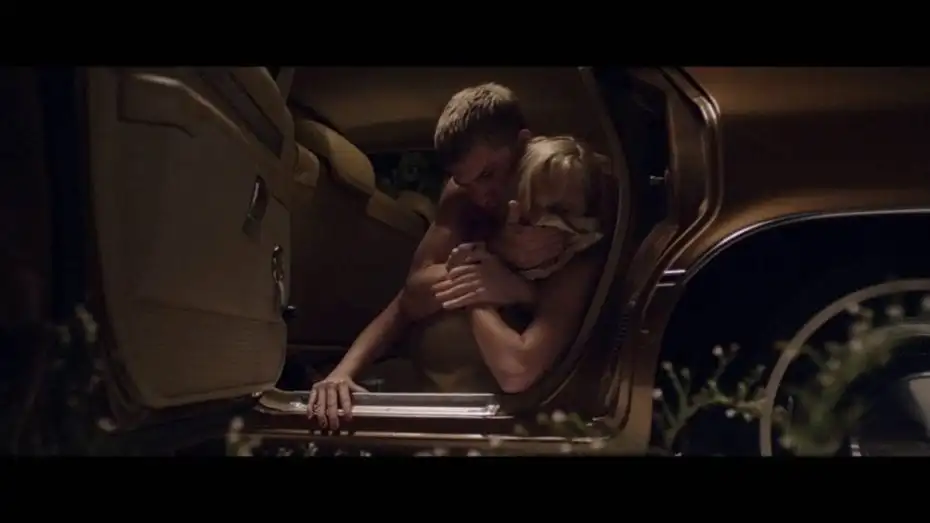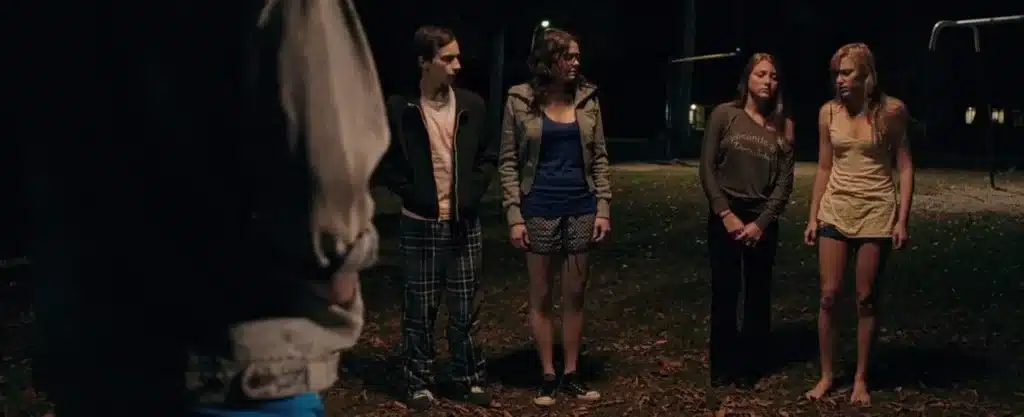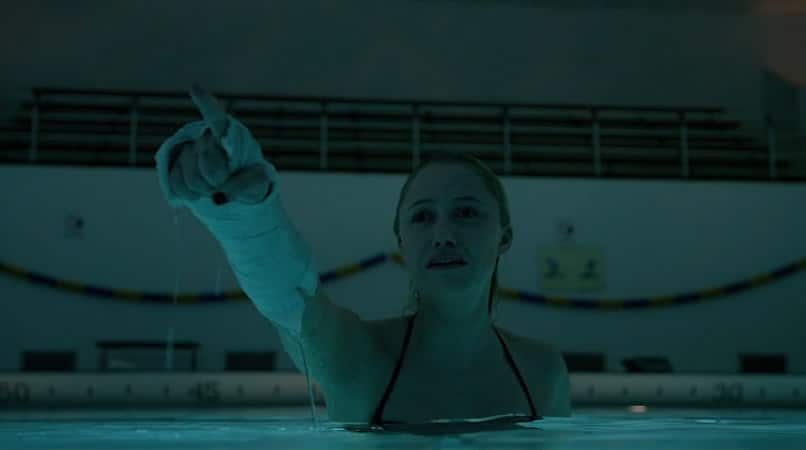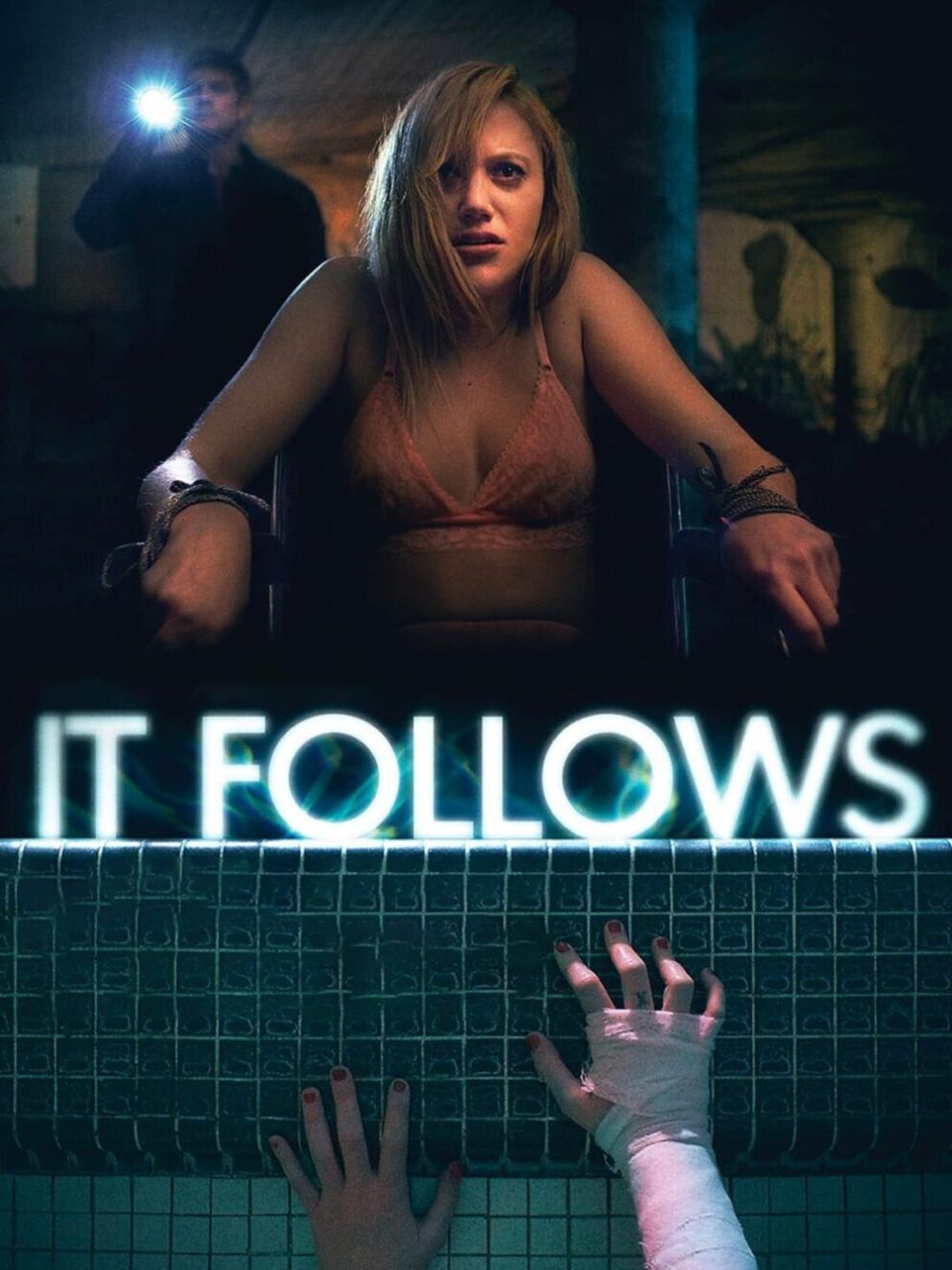Horror movies are known for having straightforward, almost rudimentary narratives that provide plenty of opportunity for the tension, thrills, fear, and gore that audiences pay for. To get an idea of how this works out, all you have to do is have a look at the daily horror movies that are available to watch. Contrary to this dominant paradigm, the 2014 independent horror film “It Follows” puts the onus back on the viewer to decipher what exactly just occurred and what it all signifies.

You’ll learn the somewhat sensible reasons for the somewhat illogical components left unanswered and the slightly rational answers to the slightly irrational questions left open in the film in this spoiler-filled explanation of the film’s numerous ambiguities.
It Follows| Synopsis of the Storyline
A kind but weird boy named Hugh starts dating college student Jay. Hugh leaves her life immediately following their first encounter with sexual activity. But, he discloses that he would be leaving behind a curse for her before he departs permanently.
According to what Jay can infer from Hugh’s psychotic ranting, Jay is allegedly currently being hunted by a terrifying monster that can assume the appearance of any person, whether it be someone Jay knows or a stranger, as a result of this sexually transmitted curse. Jay is the only person who can see the creature, in whatever form it manifests itself. She will be killed if this creature, the “It” from “It Follows,” ever manages to capture her.
Despite the lack of concrete evidence supporting the story’s truth, Jay and her pals ultimately opt to accept it at its value. They so determine that they will cooperate to finally eliminate “It” rather than letting Jay continue the path of infection. This sets up the tense, terrifying, and a little confusing final scene, in which the helpless bunch hatches a scheme fit for Scooby Doo to electrocute “It” using the numerous plugged-in home appliances that line the pool’s perimeter.
Doesn’t that sound halfway between stupid and simple? Why then do viewers of the movie perceive what they all see on screen in such radically disparate ways? It seems like the filmmaker may have wanted all of it to happen.

It Follows was filmed when?
In addition to purposefully avoiding identifying the time frame in which it takes place, the movie also seems to be purposely obscuring any hints as to when that time-frame may be.
One of the only examples of technology seen in the movie—and one that doesn’t even exist in the form shown in the movie—is the e-reader one of the characters uses. Instead, this e-reader resembles a hybrid of a more contemporary flip phone and a retro clamshell-shaped makeup compact.
The following are other aspects of the movie that play a game of anachronism with one another, completely erasing any sense of a setting in time:
All of the televisions seen in the film are either cathode ray tube (CRT) types that are a little less dated or have dials and rabbit-ear antennae.
Every television programme the characters watch is from a bygone era, either a 1950s B&W monster movie or an early cartoon.
Jay’s kitchen is decorated in a traditional 1970s style, but Greg’s refrigerator is contemporary stainless steel.
The pictures of Kelly and Jay when they were younger look too ancient to go with their current ages.
The mother of Jeff is a genuine 80s fashion icon.
Cars from the time of Henry Ford through the twenty-first century can be seen on the roads today. Also, the older cars have the same brand-new appearance as the more contemporary ones.
Fortunately, this willful disregard for another film convention—that of defining the context in place and time—is in fact deliberate. Particularly, it’s because the movie has no time period, according to director Robert Mitchell in numerous interviews. Instead, it occurs in all times and outside of all of space and time, much like a dream. In reality, Mitchell has claimed in interviews that a dream—more particularly, a nightmare in which a menacing, inexorable force was pursuing him—inspired him to write the movie, which is why he strove to give it a dreamlike quality with these plainly contradictory components.

Not a Season
There should be a season for each occurrence, but there isn’t one in this movie. A young woman sprinting outside in short-shorts and a tank top is seen at the beginning of the scene. Summer is definitely conjured up by her attire as well as the lush, green trees and grass around her. When she looks around, though, she notices that the leaves on the trees in the yards directly across from her have already begun to change colour and begin to litter the lawns. Pumpkins sit on the porch of one house, all indicating fall.
The fact that she swims in her pool before Jay’s date further suggests summer. However, everyone waiting outside the cinema for their movie date is dressed in winter clothes.
These are only two instances of how Mitchell obfuscates not only the year in time but also any sense of the time of year.
It Follows is filmed where?
Given how many of the movie’s “mistakes” were actually the director’s deliberate design, if this movie had a continuity supervisor, that person must have been tearing out their hair on the set every day. Glaring anomalies in issues of location, such as windows appearing in office walls where they previously couldn’t have fit, let alone existing, contribute to the movie’s surreal atmosphere.
What’s With the…? or Further Inconsistencies

Alongside setting-related discrepancies, the movie is also seasoned (pun intended) with sporadic uncertainty throughout, which all seem to be intended to make the spectator fight to figure out the movie’s secrets rather than giving them to them up front. Yet what they actually accomplish is to keep the viewer uneasy throughout the entire film, from the opening to the final credits.
Why is this woman always running in heels?
A young woman with heels runs away from “It” at the beginning of the movie. She wears heels, so why? Maybe it’s supposed to imply that “It” caught her off guard and that she didn’t have time to change into safe shoes before escaping for her life.
What’s up with the cans and bottles hanging from Jeff’s Hideout’s doors and windows?
The viewer is informed—without being explicitly told—that “It” does have a physical body and cannot simply enter a building by, say, walking through walls—by Jeff’s attempts to protect himself by hanging cans and bottles over his hideout’s doors and windows.
Unrecognizable Lady and Unrecognizable Guy

Throughout the movie, Jay and Kelly’s mother is portrayed in peculiar ways that all work together to make her seem more like a spectral ghost than a fellow protagonist. Her face is constantly hidden in some fashion, whether it be by light and shade or blurred focus. Furthermore, she is seen drinking during the day in every scene in the movie save the final one in Jay’s bedroom. Greg’s mother’s later remark to him that Jay’s family is “a disaster” only serves to reinforce the impression that Jay’s own mother is no longer truly, totally “present.”
Although the filmmaker has not verified it, one possible explanation for this is that Jay’s mother is traumatised as a result of the passing of her husband, Jay and Kelly’s father. The fact that the guy “It” poses as in the pivotal pool scene—possibly Jay and Kelly’s father—seems to be the same age as the man in the old wall portrait at Jay’s house, both looking in their late-30s to early-40s—supports this theory.
Another possibility for Jay’s refusal to inform Kelly what form Kelly sees “It” taking in the pool house is because he lost his father to suicide. In other scenes of the movie, the man may be seen in images standing next to Jay as a little child on her bedroom mirror or in a family picture with Jay, Kelly, and their mother all appearing to be of the same age next to the man who looks exactly the same.
The Magnificent Imitation
Jay’s sister queries her during the pivotal battle with “It” at the pool house, obviously alluding to the shape that “It” has chosen to take this time. I don’t want to tell you, Jay replied.
Later on, when the scenario is seen through Jay’s perspective, “It” makes an appearance as a character that most viewers would say they haven’t seen previously in the movie.
Audiences are wise to ponder whether this middle-aged man with a beard is one of the victim’s loved ones given that “It” occasionally impersonates them. In fact, viewers who pay close attention may note that some of the pictures on the wall at Jay’s home from earlier in the movie all feature the same man. Although it is never stated officially, it is safe to presume that he is Jay and Kelly’s father, who is likely no longer alive as already suggested.

Why Are You Being So Cagey?
To fully comprehend “It Follows,” one must look beyond simple explanations of the significance of each ambiguity in the movie and consider the greater significance of creating a movie with so many obvious ambiguities.
Hugh doesn’t know enough about the monster to be able to describe it or how it works in a way that is accurate or even fully complete. The viewer is unsure of “It’s” range of movement and whether it will be able to track down its target no matter where or how far they flee. Since they know so little about “It” to know if it would even work, the group’s plan to kill it involves electrocuting it in the pool. so forth.
Leaving so many glaring story holes in the picture, as director Mitchell essentially told Yahoo Movies, defied the typical desire for fans of the genre to simply tear apart a horror movie in order to expose all of its flaws. The movie defends itself against these claims of incongruity by giving the impression that it is unconcerned with needless backstory and explanation.
It Follows| What Happens Next?
The penultimate scene in “It Follows,” in which Jay and Paul are walking down the street after their romantic encounter, features the most uncertainty. A stranger is slowly approaching them from behind.
Which figure is it? Is it the beast itself, which is ostensibly still alive and unconquered? If so, why don’t they run for their life if it is?
According to Mitchell, the film’s finale leaves it up to the viewer to determine what occurs next and, thus, what the ending actually means. Is “It” genuinely, irrevocably dead now or not? Or is the creature still alive and the curse is still active? Nothing in the movie’s climactic seconds refutes any of these readings.
There are various interpretations of the movie that reviewers and spectators have offered that are sexual in nature. This movie, in its most basic form, is about a nasty thing that teens spread through intercourse. Because of this, some see the narrative as a critique of teens’ general promiscuity, while others delve farther to interpret it as a metaphor for STDs.
Think about the evidence
Via sexual contact, the curse is transferred from one person to another.
If at all feasible, the majority of people are notified that they have “infected.”
Only those who are currently or have been afflicted by the curse can “see” it.
Even the movie’s director has entered the competition. While he avoids directly explaining the movie or his creative decisions, he does acknowledge a philosophical framework that revolves on human mortality as an inexorable certainty from which fragile and fleeting uncertainties like sex and love may
divert, but never entirely dissuade.
Seriously, This Is It This Time,
Together, these insights show that “It Follows” has a riddle that is locked in a puzzle that is stuck in an enigma, which lies beneath its mesmerising cinematography, sumptuous soundtrack, and inventive plot twists. In other words, the more “It Follows” you watch and the more you learn about its subtleties, the more you realise how little you actually know or comprehend.
How did you feel about It Follows’ conclusion? Please leave a remark below with your ideas.
ALSO READ THIS: Time Loop Films| A Complete 2023 List -Live The Same Day Over
